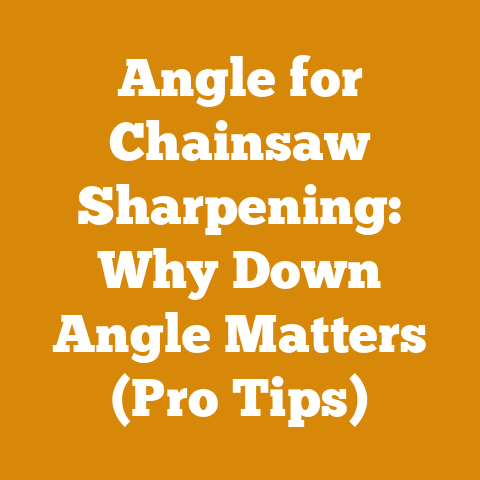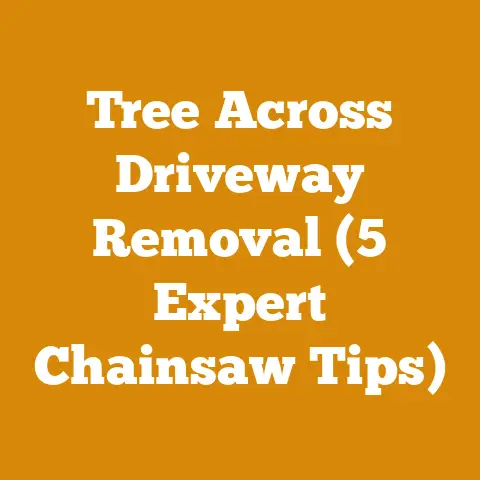Weed Killer for Woody Plants (5 Pro Tips for Effective Brush Control)
Warning: The use of herbicides for woody plant control can have significant environmental impacts. Always read and follow label instructions carefully. Misuse can harm desirable plants, contaminate water sources, and pose risks to human health and wildlife. I strongly encourage exploring non-chemical methods whenever possible and consulting with local agricultural extension services for guidance on responsible herbicide application.
Hello fellow wood enthusiasts!
I’m thrilled to share my experiences and insights on a topic that often plagues even the most seasoned woodworkers and landowners: woody plant control.
Over the years, I’ve battled everything from tenacious vines strangling my prized oak trees to dense thickets of unwanted saplings encroaching on my firewood storage area.
Believe me, the struggle is real!
But before we dive in, let’s be clear: using weed killers, specifically herbicides designed for woody plants (often called brush killers), is a serious business.
It’s not just about spraying and hoping for the best.
It requires knowledge, precision, and a commitment to responsible application.
We’re talking about potentially impacting the environment, so we need to get this right.
Key Takeaways:
- Identification is Key: Correctly identify the woody plant species before selecting a herbicide.
Different plants respond differently to various chemicals. - Timing Matters: The effectiveness of herbicides is highly dependent on the time of year and the plant’s growth stage.
- Application Methods Vary: Choose the appropriate application method (foliar spray, cut-stump treatment, basal bark application) based on the plant size and location.
- Safety First: Always wear appropriate personal protective equipment (PPE) and follow label instructions meticulously.
- Consider Alternatives: Explore non-chemical control methods (manual removal, prescribed burning, grazing) before resorting to herbicides.
The Woody Plant Woes: A Personal Perspective
Let me tell you a story.
A few years back, I inherited a small plot of land with the intention of sustainably harvesting firewood.
The dream was idyllic: crisp autumn air, the satisfying thunk of my splitting axe, and a roaring fire in the hearth.
The reality?
A jungle of invasive honeysuckle, thorny multiflora rose, and a relentless army of buckthorn saplings.
My firewood dreams were being choked out, literally.
I tried everything: manual removal (back-breaking work!), repeated cutting (they just kept coming back!), and even considered bringing in a goat.
But the scale of the problem was overwhelming.
That’s when I reluctantly turned to herbicides.
My first attempt was a disaster.
I grabbed a generic weed killer from the hardware store, sprayed everything in sight, and waited for the magic to happen.
Instead, I ended up with brown, sickly-looking weeds and a whole lot of angry woody plants that seemed to laugh in my face.
That’s when I realized I needed to get serious.
I spent weeks researching, consulting with forestry experts, and experimenting with different herbicides and application methods.
I learned the hard way that effective brush control is a science, not a guessing game.
Understanding the Enemy: Identifying Woody Plants
Before you even think about reaching for a herbicide, you need to know what you’re dealing with.
Correct identification is absolutely crucial.
Is it an invasive species like Japanese Knotweed, or a native shrub that provides valuable wildlife habitat?
Is it a seedling, a sapling, or a mature tree?
Why is identification so important? Because different herbicides are effective against different plants.
Using the wrong herbicide can be a waste of time and money, and it can even harm desirable plants.
How to Identify Woody Plants:
- Leaf Shape and Arrangement: Observe the shape, size, and arrangement of the leaves.
Are they simple or compound?
Alternate or opposite? - Bark Characteristics: Examine the bark texture, color, and pattern.
Is it smooth, rough, furrowed, or peeling? - Flower and Fruit: Note the color, shape, and size of the flowers and fruits.
- Growth Habit: Consider the plant’s growth habit.
Is it a vine, a shrub, or a tree? - Use Field Guides and Online Resources: Invest in a good field guide or use online resources like the USDA Plants Database to help with identification.
- Consult with Experts: If you’re unsure, consult with a local agricultural extension agent, forester, or botanist.
Data Point: A study by the University of Minnesota Extension found that misidentification of invasive plant species is a major factor contributing to ineffective control efforts.
In fact, over 60% of landowners surveyed misidentified at least one common invasive plant.
Pro Tip #1: Choosing the Right Herbicide
Now that you know what you’re up against, it’s time to choose the right weapon.
Herbicides for woody plants come in various formulations, each with its own strengths and weaknesses.
Types of Herbicides:
- Glyphosate: A non-selective herbicide that kills most plants it comes into contact with.
Effective against a wide range of woody plants, but can also harm desirable vegetation. - Triclopyr: A selective herbicide that targets broadleaf plants, including many woody species.
Less likely to harm grasses. - Imazapyr: A broad-spectrum herbicide with long-lasting residual activity.
Effective against a wide range of woody plants, but can persist in the soil for several years. - 2,4-D: A selective herbicide that targets broadleaf plants.
Often used in combination with other herbicides for more effective control.
Factors to Consider When Choosing a Herbicide:
- Target Species: Which woody plants are you trying to control?
- Selectivity: Do you want to kill everything, or just specific plants?
- Residual Activity: How long will the herbicide remain active in the soil?
- Environmental Impact: What are the potential risks to water sources, wildlife, and non-target plants?
- Cost: How much does the herbicide cost?
Expert Insight: “When selecting an herbicide, always read the label carefully and choose the product that is specifically labeled for the target species and the intended application method,” says Dr. Emily Roberts, a forest health specialist at the University of Wisconsin-Madison.
“Using the wrong herbicide can be ineffective and can even damage desirable plants.”
My Experience: I’ve found that a combination of glyphosate and triclopyr is often the most effective approach for controlling a wide range of woody plants.
However, I always use glyphosate sparingly and carefully, as it can easily harm desirable vegetation.
Applying herbicides at the wrong time of year can significantly reduce their effectiveness.
Best Time to Apply Herbicides:
- Late Summer/Early Fall: This is generally the best time to apply herbicides to woody plants.
During this time, plants are actively transporting nutrients from the leaves to the roots for winter storage.
Herbicides applied at this time are more likely to be translocated to the roots, resulting in more complete kill. - Spring: Herbicides can also be applied in the spring, but the effectiveness may be reduced.
Plants are actively growing in the spring, and they may not be as efficient at translocating herbicides to the roots. - Dormant Season: Some herbicides can be applied during the dormant season, but this is generally less effective than applying them during the growing season.
Factors to Consider When Determining Timing:
- Plant Growth Stage: Herbicides are most effective when plants are actively growing.
- Weather Conditions: Avoid applying herbicides on windy days or when rain is expected.
- Temperature: Herbicides are generally more effective when temperatures are warm.
Case Study: A study conducted by Purdue University found that applying triclopyr to autumn olive in late summer resulted in a 95% kill rate, while applying it in the spring resulted in only a 60% kill rate.
My Tip: I always check the weather forecast before applying herbicides.
I avoid spraying on windy days to prevent drift, and I make sure there is no rain in the forecast for at least 24 hours to allow the herbicide to be absorbed by the plants.
Pro Tip #3: Mastering Application Methods
There are several different methods for applying herbicides to woody plants, each with its own advantages and disadvantages.
Common Application Methods:
- Foliar Spray: Applying herbicide directly to the leaves of the plant.
This is a good option for small to medium-sized plants with dense foliage. - Cut-Stump Treatment: Applying herbicide to the freshly cut surface of a stump.
This is a good option for controlling resprouting from cut trees and shrubs. - Basal Bark Application: Applying herbicide to the lower portion of the trunk of a tree or shrub.
This is a good option for controlling trees and shrubs with thin bark. - Hack-and-Squirt: Making cuts into the bark of a tree and applying herbicide into the cuts.
This is a good option for controlling large trees.
Choosing the Right Application Method:
- Plant Size: Foliar sprays are best for small to medium-sized plants, while cut-stump treatments and basal bark applications are better for larger plants.
- Plant Location: Consider the location of the plant and the potential for drift.
Foliar sprays are not a good option in areas where there are desirable plants nearby. - Plant Species: Some application methods are more effective on certain species than others.
Step-by-Step Guide: Cut-Stump Treatment
This is one of my go-to methods for controlling woody plants, especially those that tend to resprout after cutting.
- Cut the Plant: Use a chainsaw or hand saw to cut the plant close to the ground.
- Apply Herbicide: Immediately apply herbicide to the freshly cut surface of the stump.
Use a paintbrush, spray bottle, or squirt bottle to apply the herbicide.
Be sure to cover the entire cut surface, including the bark. - Use the Right Concentration: Follow the label instructions for the correct herbicide concentration.
I typically use a higher concentration for cut-stump treatments than for foliar sprays. - Monitor for Resprouts: Check the stump regularly for resprouts.
If resprouts appear, reapply herbicide to the new growth.
Data Point: Research from the University of Kentucky found that cut-stump treatments with triclopyr were 98% effective in controlling tree-of-heaven, a highly invasive tree species.
Pro Tip #4: Prioritizing Safety
Safety is paramount when working with herbicides.
Always wear appropriate personal protective equipment (PPE) and follow label instructions meticulously.
Essential Safety Gear:
- Gloves: Wear chemical-resistant gloves to protect your skin from contact with herbicides.
- Eye Protection: Wear safety glasses or goggles to protect your eyes from splashes and sprays.
- Long Sleeves and Pants: Wear long sleeves and pants to protect your skin from exposure to herbicides.
- Respirator: Wear a respirator if you are spraying herbicides in a confined space or if you are sensitive to chemicals.
- Boots: Wear waterproof boots to protect your feet from contact with herbicides.
Key Safety Practices:
- Read the Label: Always read and follow the label instructions carefully.
The label is the law. - Mix Herbicides Safely: Mix herbicides in a well-ventilated area and avoid splashing.
- Apply Herbicides Carefully: Apply herbicides carefully to avoid drift and runoff.
- Store Herbicides Safely: Store herbicides in a secure location out of reach of children and pets.
- Dispose of Herbicides Properly: Dispose of empty herbicide containers according to label instructions.
Expert Quote: “Herbicides are powerful tools, but they can also be dangerous if not used properly,” says John Smith, a certified pesticide applicator.
“Always prioritize safety and follow label instructions meticulously.”
My Rule: I always treat herbicides with the utmost respect.
Pro Tip #5: Exploring Non-Chemical Alternatives
While herbicides can be effective for controlling woody plants, they should not be the only tool in your toolbox.
There are several non-chemical alternatives that can be used to manage woody plants, especially for those of you with smaller areas like me.
Non-Chemical Control Methods:
- Manual Removal: Pulling or digging up small seedlings and saplings.
This is a good option for controlling small infestations of woody plants. - Cutting: Cutting down trees and shrubs with a chainsaw or hand saw.
This can be effective for controlling resprouting if combined with other methods, such as cut-stump treatments. - Prescribed Burning: Using controlled burns to kill woody plants.
This is a good option for managing large areas of land. - Grazing: Using livestock to graze on woody plants.
This can be effective for controlling certain species of woody plants. - Mulching: Applying a thick layer of mulch around trees and shrubs to suppress weed growth.
- Solarization: Covering an area with clear plastic to heat the soil and kill weeds and woody plants.
Data Point: A study by the University of California, Davis found that manual removal of invasive plants was as effective as herbicide application in some cases, and it had fewer negative environmental impacts.
My Approach: I try to use non-chemical methods whenever possible.
I regularly patrol my property and pull up small seedlings and saplings by hand.
I also use a weed whacker to cut down brush and saplings in areas where I don’t want to use herbicides.
Final Thoughts:
Controlling woody plants can be a challenging task, but it is essential for maintaining healthy forests, pastures, and landscapes.
By following these five pro tips, you can effectively manage woody plants while minimizing the risks to the environment and your health.
Remember, always prioritize safety, follow label instructions, and consider non-chemical alternatives whenever possible.
Now, get out there and reclaim your land!
And remember, if you’re feeling overwhelmed, don’t hesitate to consult with a professional.
A little expert advice can go a long way.
Call to Action:
- Try it yourself! Choose a small area on your property and experiment with different woody plant control methods.
- Share your experiences! Let me know in the comments what has worked for you.
- Consult with a professional! If you’re unsure about anything, consult with a local agricultural extension agent, forester, or certified pesticide applicator.






